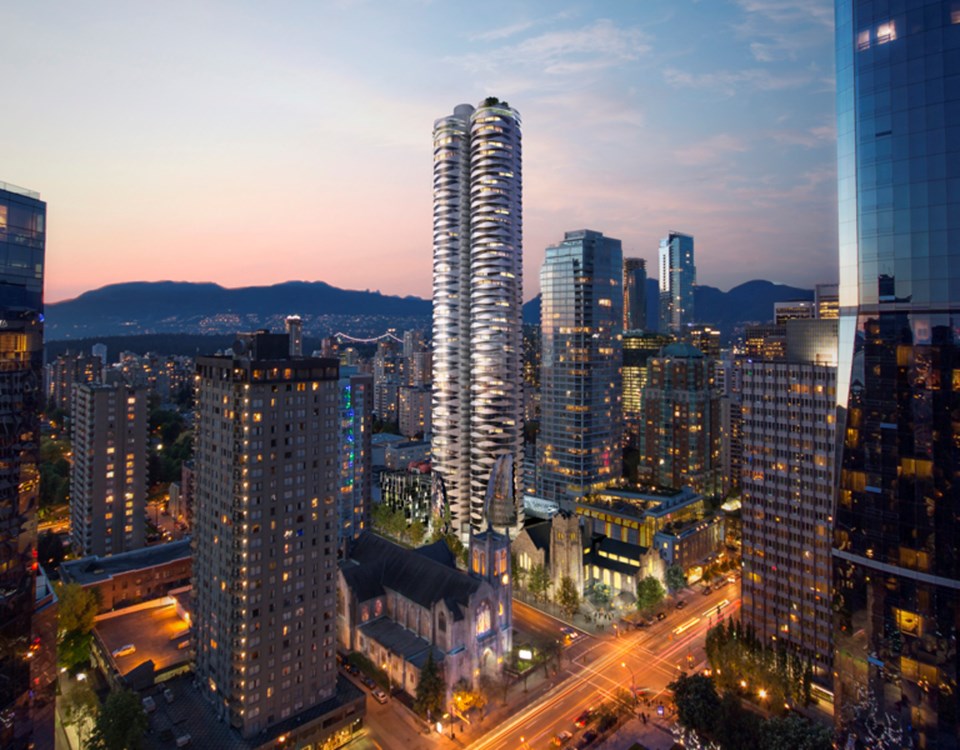Someone once asked, “When you are sitting in the bathtub with the hot water running, how do you know when to shout?”
This quotation came to mind last week when �鶹��ýӳ��city council approved a rezoning application at Nelson and Burrard.
The development includes 331 market strata units in a 57-storey tower, 61 units of social housing, seismic upgrades and restoration of a church, and expanded facilities and program space for the church and surrounding community. It will be the third tallest tower in the city, for the time being.
The development is a partnership between the First Baptist Church of �鶹��ýӳ��and Westbank Project Corp — a company I greatly admire for working with top notch architects and a commitment to design excellence. This architecturally striking tower, intended to resemble a pair of organ pipes, was designed by the late Bing Thom.
When a CBC reporter asked me what I thought of the design, I told her I thought it was very innovative and would appeal to those wanting to see more variety in �鶹��ýӳ��architecture. But I agreed with those who thought it was too big for the site and neighbourhood context.
She said she was surprised by my response. But she shouldn’t have been.
While I have often sought approvals for taller and higher density developments, in recent years I have become increasingly concerned with the size of some new �鶹��ýӳ��developments. In my opinion, they are simply too big.
However, city staff and politicians justify higher densities and heights noting the developments offer promises of greater housing affordability, community amenities and sustainability.
In supporting this development, Mayor Gregor Robertson repeatedly told reporters it would provide much needed social housing units at a time when federal and provincial subsidies were not available. He is correct.
While council rightly rejected Chinatown’s 105 Keefer St. development, other developments have been approved at greater heights and densities than many planners considered appropriate since they offered public amenities, housing affordability and Community Amenity Contributions (CACs).
They include the Independent at Kingsway and Broadway, and 508 Helmcken, which, at a floor space ratio (FSR) of 17.4, is approximately 10 times the density of a typical Kerrisdale highrise. These buildings are now under construction and time will tell if my concerns were valid.
The famous American architect Louis Sullivan once said that building form should follow function. In the case of these projects, form follows finance.
I acknowledge that there are architects, planners and developers who disagree with my concerns. They question whether it really matters if a building is 30 storeys, 40 storeys or 50 storeys. What matters more to them is how the building is designed at the street level. They believe FSR is a blunt instrument that should not be used to assess the likely success of a design.
I understand and appreciate this point of view. However, it was not that long ago that six FSR was as high as the city would allow for residential development. Today double-digit FSR residential projects, like the Burrard and Nelson development, are becoming commonplace.
The debate over when is big too big reminds me of a radio interview with the late Arthur Erickson many years ago. In describing his design philosophy, he said it was important for new developments to relate to their surroundings. When the interviewer pointed out that over time surroundings will change, Erickson agreed. But he added that future buildings should relate to his building designs, and so on.
As I look around �鶹��ýӳ��and other parts of Metro Vancouver, there is no doubt that many new developments no longer relate to their surroundings. Their designs are formed by the significant density bonuses offered in return for amenities, affordable housing and cold hard cash.
Each year Metro municipalities are now receiving hundreds of millions of dollars from developers in return for extra height and density. Many will say this is a good thing; it means property taxes will not have to go up so much.
However, I worry that if we continue to allow housing affordability and CAC payments to drive project densities, heights and massing, we may ultimately compromise the quality of the built environment that has made �鶹��ýӳ��the envy of planners from around the world.
@michaelgeller



